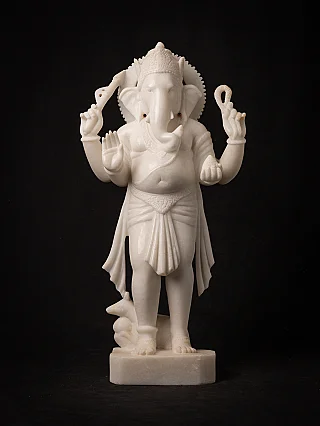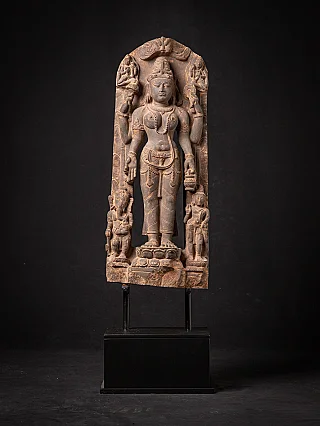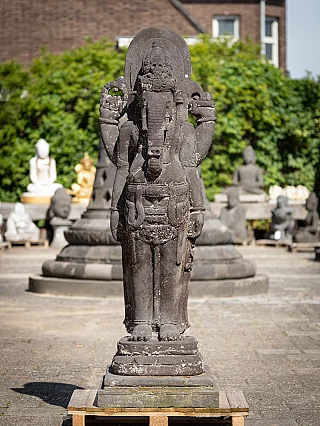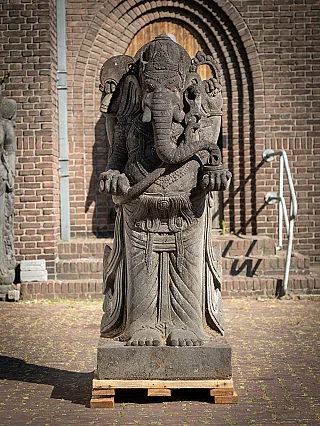Lord Ganesha - A Hindu Deity
Author : Peter Vredeveld

Ganesha, the beloved deity of Hinduism, holds a special place in the hearts of millions worldwide. Revered as the remover of obstacles, the patron of arts and sciences, and the harbinger of wisdom and prosperity, Ganesha embodies the essence of divine grace and benevolence.
Ganesha, also known as Vinayaka, Ganapati, and Vighnaharta, is one of the most widely worshipped deities in Hinduism. With his elephant head, rotund belly, and playful demeanor, Ganesha captivates devotees and seekers alike, offering solace and guidance in times of adversity. His imagery adorns temples, homes, and public spaces, symbolizing protection, prosperity, and auspicious beginnings.
Origins and Mythology
The origins of Ganesha can be traced back to ancient Hindu scriptures, particularly the Puranas and the Mahabharata. According to mythology, Ganesha is the son of Lord Shiva and Goddess Parvati. His unique appearance, with an elephant head and a human body, is the result of a divine creation by Parvati, who sculpted him from the sandalwood paste while bathing.
Legend has it that when Shiva, Ganesha's father, returned home and found a young boy guarding the entrance, he was denied entry by Ganesha. Enraged, Shiva engaged in a fierce battle with the boy, ultimately severing his head. Distressed by her husband's actions, Parvati pleaded with Shiva to revive their son. In a gesture of reconciliation, Shiva granted Ganesha new life by replacing his head with an elephant, thus bestowing upon him the unique form that he is revered for today.
Symbolism and Iconography

Ganesha's iconic form is laden with symbolism, each aspect carrying profound spiritual significance:
- Elephant Head: Ganesha's elephant head symbolizes wisdom, intelligence, and foresight. It represents the ability to perceive the subtle nuances of existence and navigate through life's challenges with grace and discernment.
- Rotund Belly: His large belly signifies contentment, abundance, and the capacity to assimilate life's joys and sorrows. It reminds devotees to embrace all experiences with serenity and gratitude.
- Modak (Sweet Dumpling): Ganesha is often depicted holding a modak, a sweet dumpling considered his favorite delicacy. The modak symbolizes the sweetness of spiritual wisdom and the rewards of devotion.
- Broken Tusk: Ganesha is depicted with a broken tusk, often holding the missing piece in his hand. According to mythology, he broke his tusk to scribe the epic Mahabharata when Vyasa, the sage, sought his assistance. This symbolizes sacrifice, humility, and the willingness to overcome obstacles for the greater good.
- Mouse (Mooshika): Ganesha's vehicle, the mouse, represents humility, adaptability, and the ability to conquer obstacles through perseverance and determination. Despite its small size, the mouse faithfully carries Ganesha, symbolizing the triumph of intellect over ego.
108 different Names of Ganesha
In the Bhagavata Purana, Lord Ganesha is given 108 names. These include Ganapati and Vinayaka, which are also used in Hindu prayers. The number 108 is considered a sacred one in Hinduism and is associated with spirituality and meditation.
These names, collectively known as "Ashtottara Shatanamavali," symbolize Ganesha's multifaceted nature and omnipresence in the lives of devotees. Here are 108 names of Ganesha:
Here are the 108 different names of Ganesha with each name in bold:
- Akhurath: One who has Mouse as His Charioteer
- Alampata: Ever Eternal Lord
- Anantachidrupamayam: Infinite and Consciousness Personified
- Amit: Incomparable Lord
- Avaneesh: Lord of the whole World
- Avighna: Remover of Obstacles
- Balaganapati: Beloved and Lovable Child
- Bhalchandra: Moon-Crested Lord
- Bheema: Huge and Gigantic
- Bhupati: Lord of the Gods
- Bhuvanpati: God of the Gods
- Buddhinath: God of Wisdom
- Buddhipriya: Knowledge Bestower
- Buddhividhata: God of Knowledge
- Chaturbhuj: One who has Four Arms
- Devadeva: Lord of All Lords
- Devantakanashakarin: Destroyer of Evils and Asuras
- Devavrata: One who accepts all Penances
- Devendrashika: Protector of All Gods
- Dharmik: One who gives Charity
- Dhoomravarna: Smoke-Hued Lord
- Durja: Invincible Lord
- Dvaimatura: One who has two Mothers
- Ekaakshara: He of the Single Syllable
- Ekadanta: Single-Tusked Lord
- Ekadrishta: Single-Tusked Lord
- Eshanputra: Lord Shiva’s Son
- Gadadhara: One who has The Mace as His Weapon
- Gajakarna: One who has Eyes like an Elephant
- Gajanana: Elephant-Faced Lord
- Gajananeti: Elephant-Faced Lord
- Gajavakra: Trunk of The Elephant
- Gajavaktra: One who has Mouth like an Elephant
- Ganadhakshya: Lord of All Ganas
- Ganadhyakshina: Leader of All The Celestial Bodies
- Ganapati: Lord of All Ganas
- Gaurisuta: The Son of Gauri (Parvati)
- Gunina: One who is The Master of All Virtues
- Haridra: One who is Golden Colored
- Heramba: Mother’s Beloved Son
- Kapila: Yellowish-Brown Colored
- Kaveesha: Master of Poets
- Kriti: Lord of Music
- Kripalu: Merciful Lord
- Krishapingaksha: Yellowish-Brown Eyed
- Kshamakaram: Place of Forgiveness
- Kshipra: One who is easy to Appease
- Lambakarna: Large-Eared Lord
- Lambodara: The Huge Bellied Lord
- Mahabala: Enormously Strong Lord
- Mahaganapati: Omnipotent and Supreme Lord
- Maheshwaram: Lord of The Universe
- Mangalamurti: All Auspicious Lord
- Manomay: Winner of Hearts
- Mrityuanjaya: Conqueror of Death
- Mundakarama: Abode of Happiness
- Muktidaya: Bestower of Eternal Bliss
- Musikvahana: One who has Mouse as Charioteer
- Nadapratithishta: One who Appreciates and Loves Music
- Namasthetu: Vanquisher of All Evils and Vices and Sins
- Nandana: Lord Shiva’s Son
- Nideeshwaram: Giver of Wealth and Treasures
- Omkara: One who has the Form of OM
- Pitambara: One who has Yellow-Colored Body
- Pramoda: Lord of All Abodes
- Prathameshwara: First Among All
- Purush: The Omnipotent Personality
- Rakta: One who has Red-Colored Body
- Rudrapriya: Beloved of Lord Shiva
- Sarvadevatman: Acceptor of All Celestial offerings
- Sarvasiddhanta: Bestower of Skills and Wisdom
- Sarvatman: Protector of The Universe
- Hambhavi: The Son of Parvati
- ShaShivarnam: One who has a Moon like Complexion
- Shoorpakarna: Large-Eared Lord
- Shuban: All Auspicious Lord
- Shubhagunakanan: One who is The Master of All Virtues
- Shweta: One who is as Pure as the White Color
- Siddhidhata: Bestower of Success and Accomplishments
- Siddhipriya: Bestower of Wishes and Boons
- Siddhivinayaka: Bestower of Success
- Skandapurvaja: Elder Brother of Skanda (Lord Kartikeya)
- Sumukha: Auspicious Face
- Sureshwaram: Lord of All Lords
- Swaroop: Lover of Beauty
- Tarun: Ageless
- Uddanda: Nemesis of Evils and Vices
- Umaputra: The Son of Goddess Uma (Parvati)
- Vakratunda: Curved Trunk Lord
- Varaganapati: Bestower of Boons
- Varaprada: Granter of Wishes and Boons
- Varadavinayaka: Bestower of Success
- Veeraganapati: Heroic Lord
- Vidyavaridhi: God of Wisdom
- Vighnahara: Remover of Obstacles
- Vignaharta: Demolisher of Obstacles
- Vighnaraja: Lord of All Hindrances
- Vighnarajendra: Lord of All Obstacles
- Vighnavinashanaya: Destroyer of All Obstacles and Impediments
- Vigneshwara: Lord of All Obstacles
- Vikat: Huge and Gigantic
- Vinayaka: Lord of All
- Vishwamukha: Master of The Universe
- Vishwaraja: King of the World
- Yagnakaya: Acceptor of All Sacred and Sacrificial Offerings
- Yashaskaram: Bestower of Fame and Fortune
- Yashvasin: Beloved and Ever Popular Lord
- Yogadhipa: The Lord of Meditation
- Yogadhipa: The Lord of Meditation
Worship and Festivities
Ganesha Chaturthi, also known as Vinayaka Chaturthi, is the most significant festival dedicated to Lord Ganesha. Celebrated with great enthusiasm and devotion across India and the world, this ten-day festival commemorates the birth of Ganesha. Elaborate rituals mark the festivities, including installing Ganesha idols, chanting prayers, and offering sweets and fruits. On the final day, devotees bid farewell to Ganesha by immersing his idols in water bodies, symbolizing his return to Mount Kailash, the abode of Lord Shiva.
Devotees pray to Ganesha throughout the year before undertaking any new endeavor or embarking on essential life milestones. Known as Vighnaharta, the remover of obstacles, Ganesha is invoked to seek his blessings for success, prosperity, and protection from adversity.
Cultural Significance
Ganesha's influence extends beyond the realms of religion and spirituality, permeating various aspects of Indian culture and society:
- Arts and Literature: Ganesha is a popular subject of artistic expression, depicted in various forms of sculpture, painting, and literature. His image inspires creativity and is a muse for artists, writers, and poets seeking inspiration and blessings for their endeavors.
- Education and Learning: Ganesha is revered as the patron of arts, sciences, and intellect. Students, scholars, and academics invoke his blessings before examinations, seeking clarity of thought, memory retention, and academic success.
- Business and Commerce: Ganesha is worshipped as the harbinger of prosperity and abundance. Business owners and entrepreneurs pray to Ganesha to seek his blessings for the success, wealth, and prosperity of their ventures.
Philosophical Teachings
Beyond his role as a deity, Ganesha embodies timeless philosophical principles that offer valuable insights for navigating the complexities of life:
- Adaptability: Ganesha's ability to adapt to changing circumstances, symbolized by his mouse vehicle, teaches the importance of flexibility and resilience in overcoming obstacles.
- Wisdom: Ganesha's elephant head symbolizes wisdom and discernment, reminding devotees to cultivate intellectual curiosity, insight, and foresight in their pursuit of knowledge and understanding.
- Sacrifice and Humility: Ganesha's broken tusk symbolizes sacrifice and humility, highlighting the importance of selflessness and humility in spiritual growth and personal development.
Conclusion
In conclusion, Ganesha, the divine remover of obstacles, embodies the essence of divine grace, wisdom, and benevolence. His iconic form, rich symbolism, and enduring significance in Hindu culture and spirituality inspire devotees to cultivate inner strength, knowledge, and resilience in facing life's challenges. As the beloved patron of arts, sciences, and prosperity, Ganesha continues to be revered by millions worldwide, offering solace, guidance, and blessings to all who seek his divine presence.
Share this page




























